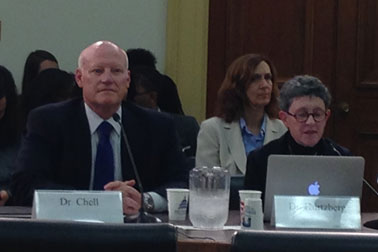Bill Proposes Re-Authorization of Stem Cell Act
CBA testimony supports $23 million per year for inventory growth and diversity[UPDATE: The legislation was passed in the House. See the update on The Stem Cell Act Re-Authorization here] Legislation that reauthorizes funding for cord blood and bone marrow programs for five additional years has been introduced by a bipartisan group of lawmakers in the United States House of Representatives. The CBA, together with representatives of the National Marrow Donor Program (NMDP), worked with legislators to craft the Stem Cell Therapeutic and Research Reauthorization Act of 2015 (H.R. 2820). Testifying in support of the bill before a House health subcommittee hearing, CBA President Joanne Kurtzberg recommended ways to improve the administration of the National Cord Blood Inventory (NCBI), through which more than 3,800 units of cord blood have been released for transplant. “Continuation and refunding of the program is essential to continue to increase the number of units listed in the NCBI and also to increase the size and diversity of units banked,” Dr. Kurtzberg told legislators at the hearing. “The potential for cord blood to treat additional serious and life-threatening diseases is just beginning to be realized.” Dr. Kurtzberg is a professor at Duke University and director of the Carolinas Cord Blood Bank. The NCBI program provides federally funded grants to public cord blood banks to assist in collecting diverse cord blood units, which are then listed on the “Be The Match” registry administered by the NMDP. Over the past 30 years the registry has grown to include 11 million adult volunteer bone marrow donors and 193,000 donated cord blood units. Through international relationships, physicians and patients worldwide have access to 24.5 million additional potential donors and 622,000 cord blood units. Program ImprovementsThe original authorizing legislation in 2005 called for FDA licensure of unrelated donor cord blood banks. To date, five cord blood banks have been granted FDA licenses. “The process of obtaining and maintaining a license has been challenging for the public banks to date,” Dr. Kurtzberg said. “Many of the regulations, created for drug manufacturing, are not easily applied to manufacturing of cord blood units.” She said that examples of problematic FDA requirements are irrelevant unit expiration dates, duplicative validations, unnecessary environmental monitoring requirements and meaningless stability protocols. “Licensure has greatly increased the costs associated with public cord blood banking, diverting limited resources from the recruitment and collection of cord blood donors and banking of new cord blood units. “Times for approvals of manufacturing changes and other aspects of the current FDA regulations are seen by some as stifling innovation and progress in the field,” she said. Dr. Kurtzberg also urged that the 150,000-unit target for the NCBI inventory, included in previous legislation, is outdated today. “Rather than targeting a specific number for the inventory, the largest and most diverse units should be targeted. As such, funding strategies should be readjusted to enable increased collections and banking of the largest, racially diverse units.” Expanded IndicationsPointing toward the future, Dr. Kurtzberg said that cord blood is showing enormous potential in the emerging fields of cellular therapies and regenerative medicine, in addition to expanded use in patients with malignant and genetic diseases. “Cord blood-derived vaccines against viruses and certain types of cancers are currently under development and in early phase clinical trials. Cells, manufactured from cord blood units, are being developed to boost recovery of the immune system. Cells regulating autoimmunity are also in early clinical trials. These approaches, which often utilize cord blood banked in family banks, may help patients with Type I Diabetes, as well as other diseases.” She said that clinical investigators are developing uses for cord blood to treat acquired brain disorders. “Over the past six years, we have initiated trials of autologous cord blood in babies with birth asphyxia, cerebral palsy, hearing loss, and autism,” she said. “We now realize that it will never be possible for all patients who might benefit from cord blood therapies to have access to their own cord blood. For this reason, we are exploring the use of donor cord blood to treat adults with acute stroke. If this proves to be safe, we plan to also test the safety and efficacy of donor cord blood infusions in children with cerebral palsy, autism and other brain injuries. H.R. 2820 was introduced by a bipartisan group of lawmakers led by Reps. Chris Smith (R-NJ) and Doris Matsui (D-CA). It would authorize $23 million per year for the National Cord Blood Inventory from 2016 through 2020, and $30 million per year for the C.W. Bill Young Transplant Program over those same years. CBA leaders are working with members of the Senate to ensure that similar legislation is introduced in that chamber in the near future. A video recording of the hearing can be viewed online. The CBA testimony is also available for download. |

